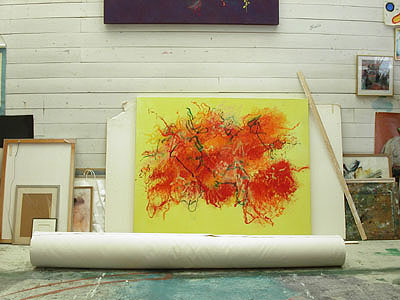|
December
10, 2004
Cleve Gray, 86, a Painter of Large Abstract Works, Dies
By KEN JOHNSON
Cleve
Gray, a painter admired for his large-scale, vividly colorful and lyrically
gestural abstract compositions, died on Wednesday in Hartford. He was
86.
The cause was a massive subdural hematoma suffered after he fell on
ice and hit his head on Tuesday outside his home in Warren, Conn., said
his wife, the writer Francine du Plessix Gray.
Mr. Gray achieved his greatest critical recognition in the late 1960's
and 70's after working for many years in a comparatively conservative
late-Cubist style. Inspired in the 60's by artists like Jackson Pollock,
Clyfford Still, Mark Rothko and Helen Frankenthaler, Mr. Gray began
to produce large paintings using a variety of application methods -
pouring, staining, sponging and other nontraditional techniques - to
create compositions combining expanses of pure color and spontaneous
calligraphic gestures.
In 1972 and 73 he produced "Threnody," a suite of 14 paintings, each
measuring 20 feet by 20 feet, dedicated to the dead on both sides in
the Vietnam War. The series was commissioned by the Neuberger Museum
of Art at Purchase College, part of the State University of New York,
and is considered one of the largest groups of abstract paintings created
for a specific public space.
Cleve Ginsberg was born in New York on Sept. 22, 1918. (The family changed
its named to Gray in 1936.) He attended the Ethical Culture School in
New York, and completed his college preparatory studies at Phillips
Academy in Andover, Mass., where he won the Samuel F. B. Morse Prize
for most promising art student. In 1940 he graduated summa cum laude
from Princeton with a degree in art and archaeology. He wrote his thesis
on Chinese landscape painting. Chinese painting would later become an
important influence on his own painting.
Mr. Gray joined the Army in 1942 and served in Britain, France and Germany,
where he sketched wartime destruction. After the liberation of Paris
he began informal studies with the French artists Andréé Lhote and Jacques
Villon, and he continued those studies after the war.
He began to exhibit his work at the Galerie Durand-Ruel in Paris, and
he had his first solo exhibition at the Jacques Seligmann Gallery in
New York in 1947, a year after returning to the United States. Mr. Gray's
work is included in the collections of the Metropolitan Museum of Art,
the Museum of Modern Art, the Whitney Museum of American Art and many
other museums. His most recent exhibition of new paintings was in 2002
at Berry-Hill Galleries in Manhattan. When he died he was working on
pictures for a show scheduled for this winter at Berry-Hill.
In 1949 Mr. Gray bought the house in Warren that remained his home for
the rest of his life. In 1957 he married Francine du Plessix, who became
well known as a novelist and essayist.
Mr. Gray also wrote frequently about art. He was a contributing editor
for Art in America magazine and he edited three volumes of other artists'
writings: "David Smith by David Smith" (1968); "John Marin by John Marin"
(1970) and "Hans Richter by Hans Richter" (1971) (all published by Holt,
Rinehart & Winston).
Mr. Gray is survived by his wife; their sons, Thaddeus, of Manhattan,
and Luke, of Brooklyn; and four grandchildren.
|
